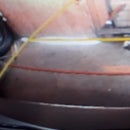Introduction: Wheel Barrow - Tray Repair
Being a fan of the old style contractors wheel barrow with the steel tray, and having recently lost mine to rust, i managed to come across a free replacement in really good order - but for a couple of holes in the corners of the tray.
Not lucky enough to have a Mig, i knew straight away the gauge ruled out using my stick welder... so after a search of Instructables coming up with nothing.. i put together some ideas... with great success:-)
Step 1: Repair Wheel Barrow Tray
I used;
- Angle grinder with grinding wheel (and associated safety equipment: mask, eye protection and ear muffs)
- Recipro saw with metal blade
- Cold chisel / old screw driver
- Wire brush
- Power drill, 2 is easier if you have the luxury!
- Drill twist bit to suit the blind rivets - 4.6mm
- Drill twist bit approx halve the diameter of the first (ie:2-3mm)
- Blind rivets - alloy 6.4mm
- Blind river hand tool
- Couple of metal files of various size
- Ball pein hammer ( could have done with a few more sizes of ball- one flat side one with a halve ball)
- sheets of paper
- marking pen
- sheet of light tin
- Tin snips, or super scissors
Step 2: Preperation
- Park up the wheel barrow - ideally on a bench at a comfortable level.
- Go to the hole that you want to repair and draw a line around the margin 10mm or so past any rust edge or damage to the edge of the hole ( so you get a nice clean line)(diagram 1)
- Using a combination of the Hammer, cold chisel/ old screw driver, knock out all rust from the margins of the hole.
- Take the Recipo saw (or Angle grinder with a cutting wheel- what ever works best for you) and cut around the border line you drew so you end up with nice straight clean solid metal margins to the hole you want to fix...(Picture 1)
- Using the file or Angle grinder with a grinding wheel, clean up any sharp edges on both sides with a slight rounding to the edge... hammer down any sticky up bits
- File / grind off any paint or loose rust around the margin you have cut, so you have straight clean margins.
Step 3: Template
- Place the tray in a sunny spot ( sun shining on the outer surface of the hole / or use a lamp if indoors)
- Cut out a piece of paper, at least 2 times the dimensions of the hole.(picture 2)
- Place the paper over the hole and you will immediately see the outline of the hole showing through the paper, (picture 2 -(b)) then draw a line around the hole, approx 20mm out side the edge of the hole (picture 2-(c))
- Pushing the paper down into the tray, mark any creases that naturally form with a pen mark (picture 3- (a)
- Lay out the sheet metal, and place the paper pattern over it,(picture 4) cutting around the edges with tin snips or supper scissors.
- Now cut along any crease lines you marked out above.(picture 5)
Step 4: Repair
Put the smaller drill twist bit in the drill and plug in and place it with in easy reach inside the wheelbarrow trail
Plate the rivets and rivet gun,and ball pein hammer also within easy reach.
- Place the paper pattern back over the hole on the inside of the tray,(allows you to see the position of the hole and line it up correctly) the place the sheet metal over the paper and line up the edges with the paper edges.
- Holding the sheet metal in place, drill a pilot hole in one corner -remember to take in to account the associated "factors" listed in diagram 2
- Swap out the pilot twist bit for the drill bit matching the rivet size - line up the pilot holes and drill out the final hole (this steps is just required for the initial rivets and any over "terrain")
- File off the outer side of the hole if required, then push the rivet in from the inside and fasten with the rivet tool.(picture 7)
- Now press the sheet metal into the shape of the barrow tray location, using the Ball pein ball / head if required to shape the patch as required(picture 8)
- Then place and repeat the rivet hole procedure in 1 to 4 above at the opposite corner of the patch to anchor it in position,
- Then go ahead and start drilling only pilot holes around the edge. I spaced them approx 20mm apart - except where there was a crease cut or other angle etc, where i would put one either side while holding the feature in place.
- Drill out the rivet final holes and place and fasten the remainder of the rivet's around the patch margin (picture 9)
Step 5: Finish
With the patch in place (picture 10) i had thought bout going to work with autofiller on the outside.... for a little extra bind..... but i haven't as yet.. because i had some wheelbarrow duties that took priority... seems to work ok with out the cosmetics?
The other day we had heavy rain and the barrow went a head and became an impromptu water tank....













